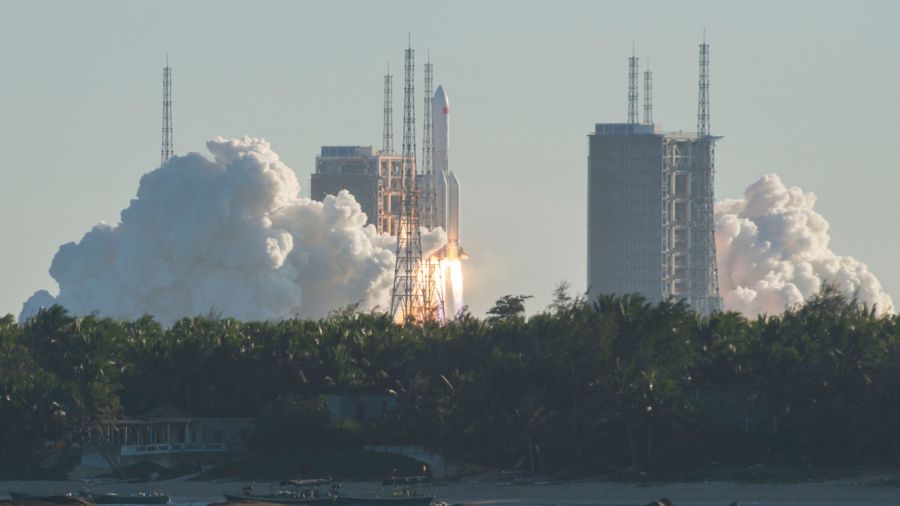The body of a Chinese rocket launched earlier this month reentered Earth’s atmosphere on May 11, making it the largest uncontrolled object to uncontrollably fall out of orbit in decades.
Remnants of the rocket that survived reentry was about the “size of a large van or a small bus,” according to the U.S. military, which was monitoring the trajectory of the falling object just off the west coast of Africa.
China’s Long March 5B rocket was launched May 5 from the Wenchang launch center in the southern island province of Hainan, which extends into the South China Sea. The rocket was fitted with a prototype version of China’s next-generation crew capsule.
Following almost a week of orbiting the Earth, the core stage of the large rocket re-entered the atmosphere on Monday and landed in the Atlantic Ocean, according to spokesman for the U.S. Space Force’s Combined Force Space Component Command.
“The Combined Force Space Component Command (CFSCC), through the 18th Space Control Squadron (18 SPCS), confirmed the Chinese CZ-5B R/B (Satellite Catalog #45601) reentered the Earth’s atmosphere over the Atlantic Ocean at approximately 08:33 (PDT) May 11,” Maj. Cody Chiles told The Epoch Times.
“The object was approximately 20 meters squared (the size of a large van or a small bus). The CFSCC used Space Surveillance Network sensors and their orbital analysis system to confirm the Chinese rocket body re-entry,” he added.
The body was the largest object to make an uncontrolled reentry since the Soviet Union’s 39-tonne Salyut-7 which launched on April 19, 1982, and returned in February 1991, according to Dr. Jonathan McDowell, a satellite expert from Harvard-Smithsonian’s Center for Astrophysics.
And the TIP message is out, showing reentry at 1534 UTC at location 20W 20N, just before the ground track passed over Nouakchott. pic.twitter.com/wcQ7BmJblk
— Jonathan McDowell (@planet4589) May 11, 2020
Dead satellites and old rocket stages regularly re-enter the atmosphere, but re-entering objects with masses of more than a few tons are rare.
Dr. Combs, a Dee Howard Endowed Assistant Professor in Aerodynamics in the UTSA Department of Mechanical Engineering, noted that while the body appeared to have landed safely on this occasion, it is extremely difficult to engineer vehicles that safely survive reentry as it is “highly probable that portions of the rocket survive reentry and land somewhere.”
“While we quite literally dodged a bullet here it does not excuse the reckless design choices that created this hazard,” he wrote on Twitter. “Unfortunately this is the first of several Long March 5B missions and there is no indication there will be changes made. So we’ll be playing this game again soon.”
This is also not the first time Chinese space objects have plunged to earth in an uncontrolled manner. In 2011, the 18,000-pound Tiangong-1 prototype Chinese space station went rogue traveling at 17,000 miles per hour. Tiangong-1, which means Heavenly Palace in Chinese, was launched in September before breaking up in April 2018 and burning in the atmosphere, creating debris that hurtled uncontrollably towards Earth.
The Chinese military continues to invest heavily in its own state-run space programs and is becoming one of the largest investors in private companies, while president Xi Jinping “has emphasised the importance of science and technology (S&T) innovation, both for rejuvenating China and modernising China’s military.”
In August 2019, the Trump administration warned that the Chinese communist regime has been working to displace the United States as the leading space power.
President Donald Trump re-established U.S. Space Command as the Defense Department’s 11th Unified Combatant Command on Aug. 29, 2019, in response to adversaries like China developing advanced anti-satellite weapons.
From The Epoch Times

